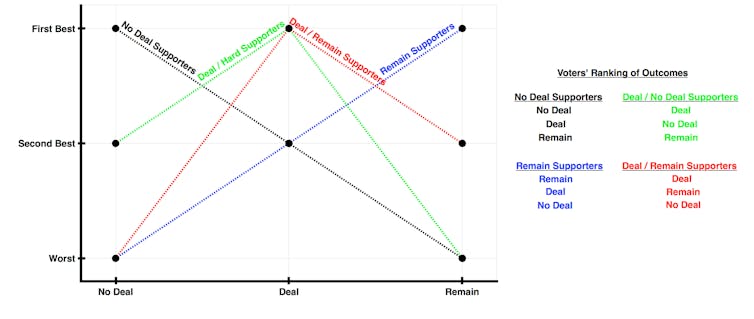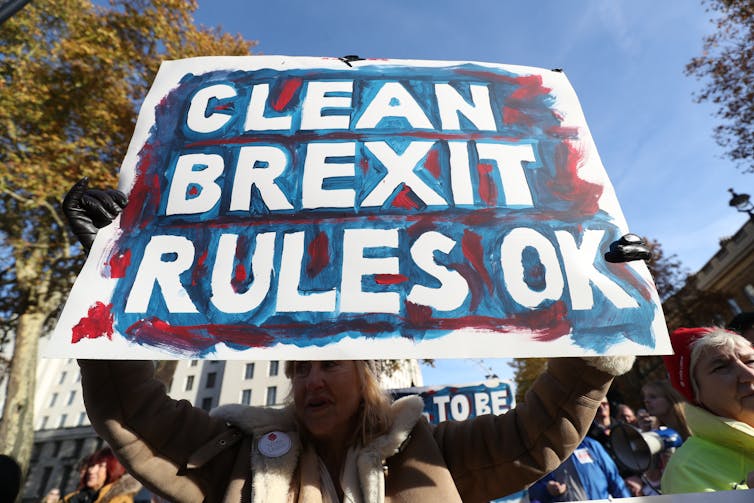The 2016 EU referendum resulted in a marginal victory for Brexit and a divided nation. After two years of negotiations, politicians and voters seem further divided. The final decision may now be put back in the hands of voters in another referendum. So how could such a referendum produce an outcome to settle the debate? Or at least, could we design a referendum that will not be perceived as an effort to overturn the 2016 decision? The answer is not easy, and different designs lead to different outcomes. As we however argue, while certain designs favour consensus, others may lead to further divisions.
Consider the three available options on a scale running from anti to pro-EU. The two options of remaining in the EU or exiting without a deal lie at the two extremes of the scale. Leaving the EU with the negotiated deal lies somewhere between. This would make a two-option referendum controversial so a three-option vote might be preferable. However, that raises the question of how you get a meaningful mandate.
We argue that a “Borda count” (named after the 18th-century mathematician Jean-Charles de Borda) should be used in this three-way referendum. On polling day, voters rank the three options, marking their favourite with a “1”, their second favourite with a “2”, and their worst option with a “3”. For each ballot, the rule assigns 2 points to each voter’s first option, 1 to their second, and 0 to their third. The option with most points wins.
With a Borda count, if an option is supported by a majority, the rule delivers it (as any other reasonable rule would do). If no single option is supported by a majority, the Borda count in the particular setting works well. As we will argue, it would most likely deliver the option that would have also won in a two-way referendum against either alternative. This would guarantee a certain degree of consensus.
The setting
In the case of Brexit, we think you can divide voters into four groups:
1) “No-deal supporters” want to leave the EU without a deal. If not possible, they would rather leave the EU with a deal rather than remain.
2) “Remain supporters” want to remain. If not possible, they would rather leave the EU with a deal than crash out of it.
3) “Deal/no-deal supporters” want to leave the EU with a deal. Their second preference is to leave the EU without a deal and their worst option is to remain.
4) “Deal/remain supporters” also want to leave with a deal, but they would rather remain in the EU than crash out of it.

Consider that none of the options is ranked first by at least 50% of voters. A Borda count in a three-way Brexit vote would most likely deliver the “deal” option. While this might sound like a terrible result to some, in the absence of a clear majority it’s actually the least divisive option.
That’s because in the absence of at least 50% of “no-deal” or “remain” supporters, accepting the deal would also win against both other options in two-option referenda. Consider a “deal” versus “no deal” referendum: “deal” and “remain supporters” vote for the deal, “no-deal supporters” oppose it. Since “no-deal” supporters are not a majority, “remainers” and “deal supporters” give the victory to the “deal”.
Similarly, in a “remain” versus “deal” referendum, “no deal” and “deal” supporters give the victory to the “deal”.
The desirable feature of the Borda count is precisely this: it delivers the consensual “deal” option in a divisive scenario where no option is supported by a clear majority. Of course, it would also deliver a victory for any of the three options if one were supported by a clear majority. Hence, while it gives both “extreme” options (“remain” and “no deal”) fair chances, it delivers a “moderate” soft Brexit in the absence of a clear majority.
The above features make the Borda count a credible design that treats all options equally. It’s a design that parliamentarians could get behind as momentum builds towards holding a referendum. And, should such a referendum happen, this neutral design could help deliver a result voters can trust.
Consider the alternatives
We think that any other system would fail to produce a result that can truly resolve this question. A first-past-the-post three-option referendum would obviously fail to promote consensual options. It could give the victory to one of the extreme outcomes with 34% of the total vote – with the other two options tying at 33%.
Others propose a two-question referendum in which question one repeats the original EU referendum question and question two asks voters to choose a preferred type of Brexit. This has similar properties to the Borda count. However, if you repeat the original referendum question on the new ballot, you invite criticism that you are simply rerunning the 2016 vote, which risks perpetuating Brexit divisions. The Borda count is more neutral: it treats all options equally.

In this context, there are also problems with using a transferable vote system, as supported by Conservative MP Justine Greening. As with the Borda count, voters return a simple ranking. If there is no alternative ranked first by a majority, the option that got the least first preferences is eliminated. These votes are then allocated to the two other options following the second ranked option.
In the polarised scenario at hand, if there is no majority for one of the “remain” or “no-deal” options to guarantee those options a straight win, the “deal” option would most probably have the least first preferences. Hence the transferable vote would eliminate the moderate option first and one of the extreme options would win. This is, in our view, an undesirable feature of this system since as we previously established the moderate option would most likely win against both other options in a two-way referendum.
That’s why we think the three-way, Borda count vote is the best option for finding a way out of this Brexit mess.![]()
Orestis Troumpounis, Senior Lecturer, Lancaster University and Dimitrios Xefteris, Assistant Professor of Political Economy, University of Cyprus
This article is republished from The Conversation under a Creative Commons license. Read the original article.